What Is the Symbolic Meaning of a Raven? Mystery!
The raven symbolizes a range of meanings including mystery, intelligence, transformation, and prophecy across various cultures. It often represents a deep connection with the spiritual realm and is considered a powerful totem or spirit animal.
The raven’s symbolic meaning varies:
- Mystery and Intelligence: Ravens are known for their problem-solving skills and cunning nature, which have associated them with mystery and wisdom.
- Transformation and Prophecy: In some mythologies, ravens are seen as oracles or messengers, indicating change or revealing omens.
- Death and Rebirth: Their black plumage links them to the afterlife and the subconscious, symbolizing the cycle of death and rebirth.
For example, in Norse mythology, Odin, the god of wisdom and war, had two ravens, Huginn (thought) and Muninn (memory), who gathered information for him.
Embodying the essence of the unknown, ravens are captivating symbols of the mystical ties between life, death, and rebirth.
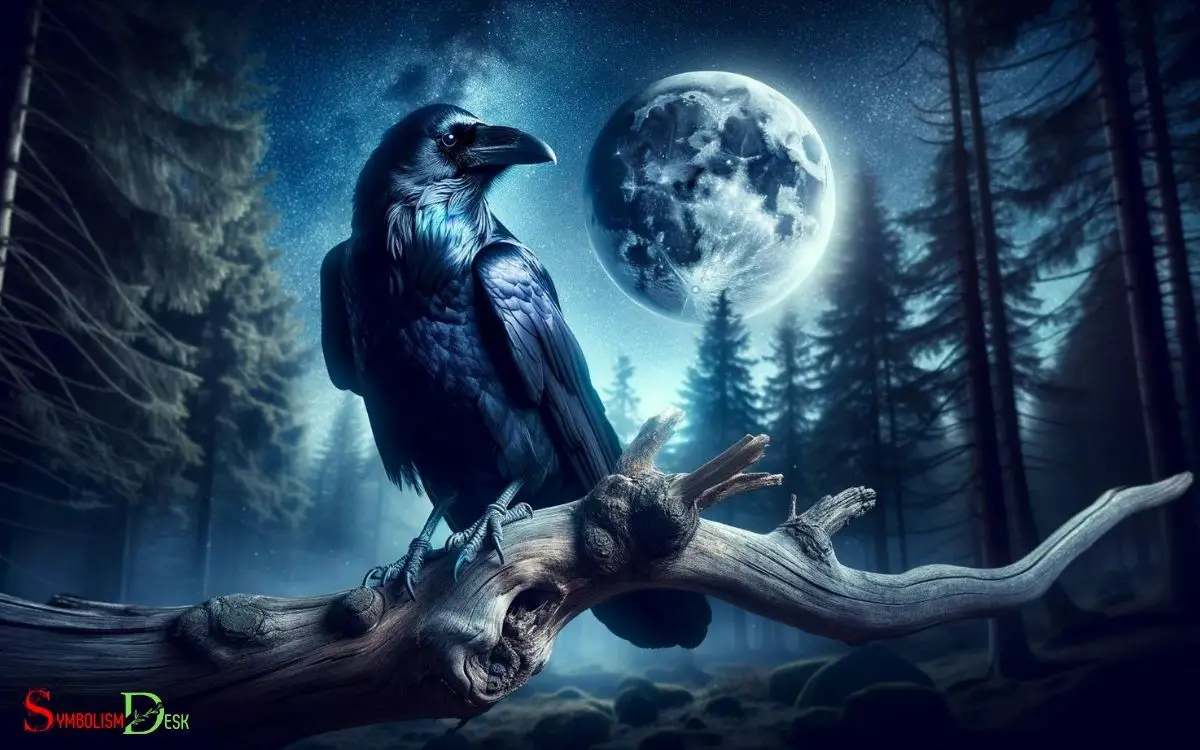
Key Takeaway
Origins of Raven Symbolism
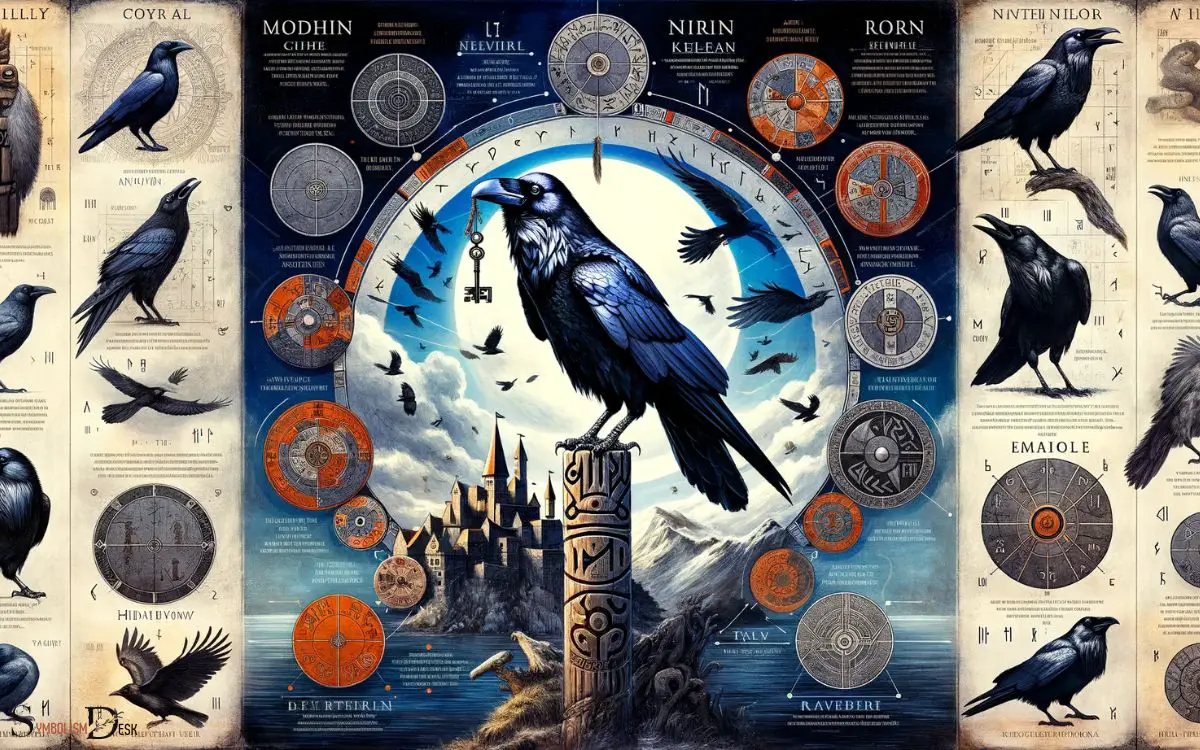
Where did the symbolism of the raven originate?
The symbolism of the raven has deep historical roots across various cultures. In ancient mythology, the raven is often associated with wisdom, prophecy, and magic.
In Norse mythology, Odin, the god of wisdom, was accompanied by two ravens, Huginn and Muninn, who represented thought and memory.
In Native American cultures, the raven is seen as a trickster figure and a symbol of transformation. Its black plumage and haunting call have also contributed to its association with mystery and the unknown.
The raven’s intelligence and adaptability have further cemented its symbolic significance. These diverse cultural interpretations have collectively contributed to the rich and varied symbolism of the raven that persists to this day.
Raven Symbolism in Different Cultures
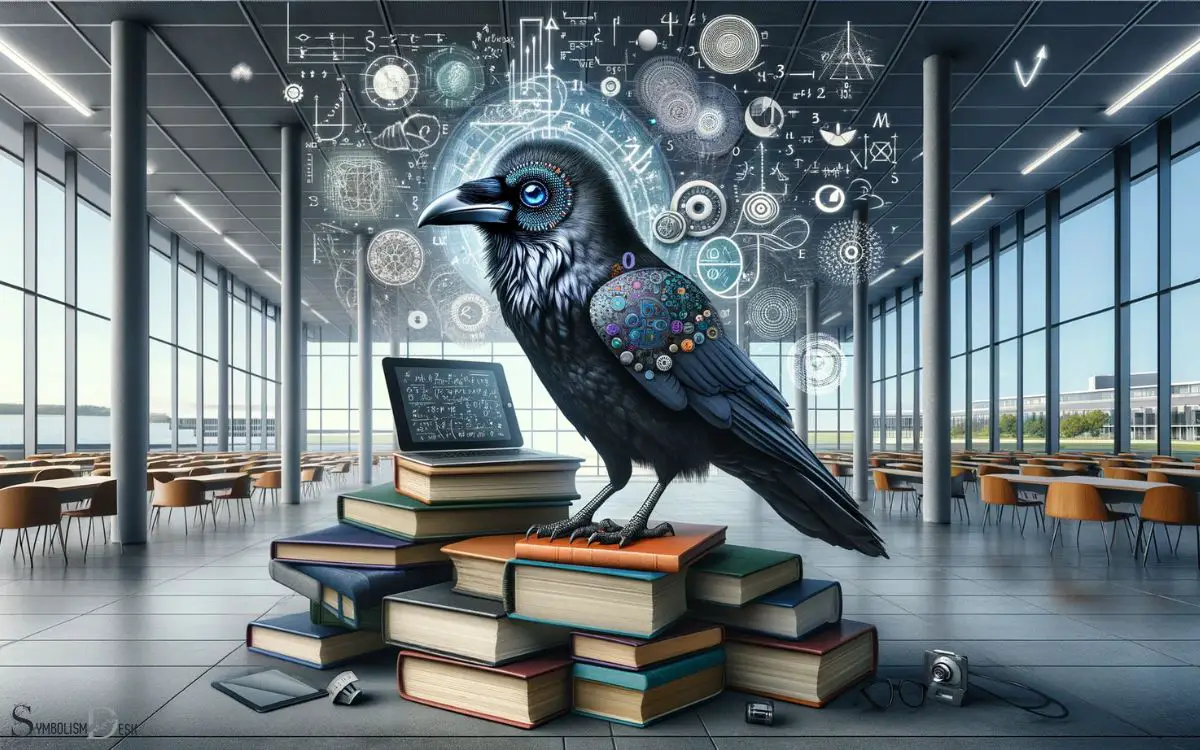
Raven symbolism varies across different cultures, reflecting diverse interpretations and beliefs about the bird’s significance.
In ancient mythology and folklore, the raven’s symbolism is deeply rooted and continues to be a subject of fascination and reverence.
In Norse mythology, the raven is associated with Odin, the god of wisdom, war, and death, symbolizing intelligence and keen perception.
Among Native American cultures, the raven is often considered a trickster figure, representing transformation, knowledge, and the complexity of nature.
In Celtic traditions, the raven is linked to the supernatural and serves as a messenger between the human world and the spirit realm.
In Eastern cultures like Chinese and Japanese, the raven is often a symbol of good luck and protection.
These varied interpretations highlight the raven’s enduring significance and its ability to embody diverse cultural meanings.
The Raven as a Messenger
The raven, as a messenger, plays a significant role in various cultural beliefs and mythologies, serving as a conduit between the human world and the spirit realm.
In many cultures, the raven is seen as a messenger between the mortal and immortal realms, carrying information and guidance from one world to the other.
For example, in Norse mythology, Odin, the god of wisdom and war, had two ravens, Huginn and Muninn, who flew around the world and brought him information.
In Native American cultures, the raven is often considered a mediator between the physical and spiritual worlds, bringing messages from the spirit realm to the human world.
This aspect of the raven as a messenger highlights its connection to the unseen and its role as a communicator of important knowledge and guidance.
This role as a messenger seamlessly leads into the subsequent section about the wisdom and intelligence associated with ravens.
Wisdom and Intelligence Associated With Ravens
Associated with ravens is the profound wisdom and intelligence they exhibit in various cultural beliefs and mythologies. In many ancient cultures, ravens were revered for their keen intellect and ability to problem-solve, which led to them being associated with wisdom and foresight.
Here are three examples showcasing the wisdom and intelligence associated with ravens:
- Norse Mythology: In Norse mythology, the god Odin had two ravens, Huginn and Muninn, who served as his messengers and would fly around the world to gather information for him, symbolizing the wisdom and intelligence of the ravens.
- Indigenous North American Cultures: Many indigenous North American cultures consider the raven as a symbol of wisdom and knowledge, often depicted as a trickster figure who uses intelligence and wit to outsmart others.
- Literary Works: In literature, ravens are often portrayed as wise and insightful, such as in Edgar Allan Poe’s famous poem ‘The Raven,’ where the raven’s repeated refrain of ‘Nevermore’ reflects a deep understanding and knowledge.
Transformation and Rebirth Symbolism
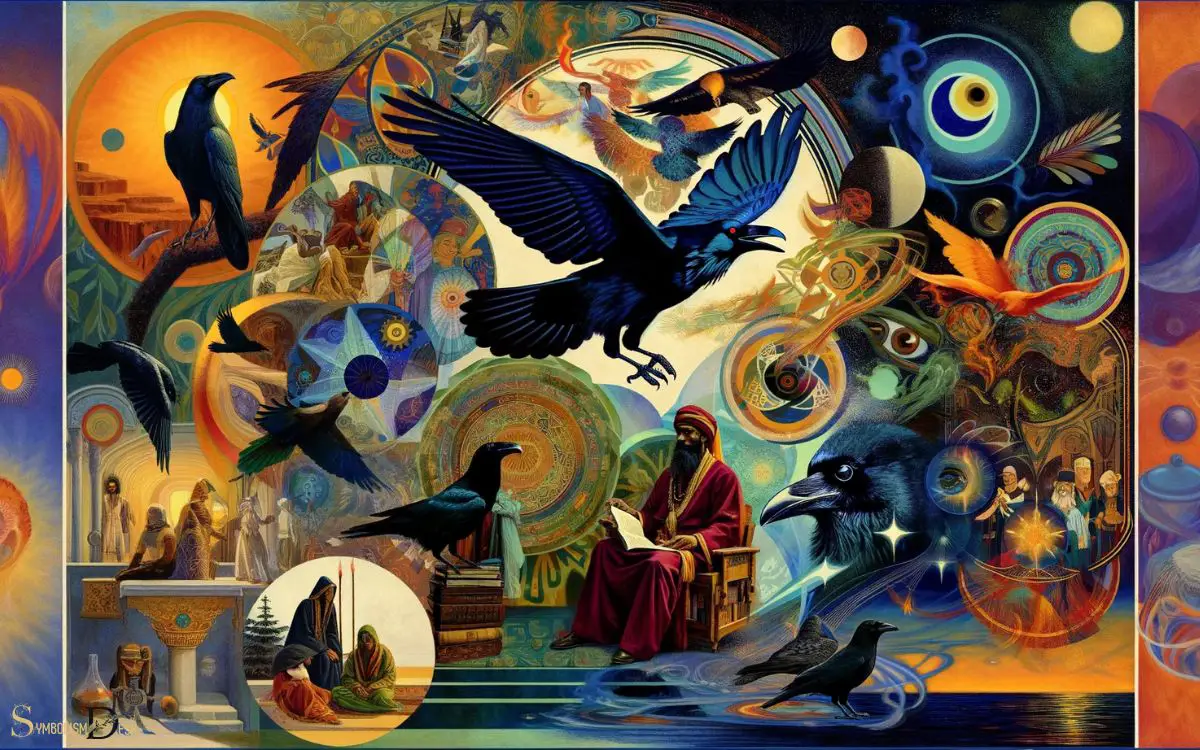
Transformation and rebirth are symbolized by the raven in various cultural beliefs and mythologies. The raven’s association with transformation is deeply rooted in its ability to adapt to different environments and its connection to change.
In many indigenous cultures, the raven is seen as a symbol of metamorphosis and renewal. Its dark plumage and haunting call evoke a sense of mystery and the unknown, often linked to the transformative process.
Additionally, the raven’s role in folklore and mythology as a messenger between the mortal world and the afterlife reinforces its connection to rebirth and spiritual transformation.
The raven’s symbolism in transformation and rebirth serves as a powerful reminder of the cyclical nature of life and the potential for growth and renewal.
Raven Symbolism in Folklore and Myths
Raven symbolism in folklore and myths holds significant cultural importance. The raven is often portrayed as a messenger, delivering important messages to humans and deities alike.
This portrayal highlights the raven’s role as a bridge between different realms and its ability to convey knowledge and wisdom.
Additionally, the raven is commonly depicted as a trickster figure in various cultural narratives. It uses its intellect and cunning nature to navigate through challenges and bring about change.
In these stories, the raven’s trickster qualities are often seen as both mischievous and transformative, representing the unpredictability of life and the need to adapt to new circumstances.
Understanding the multifaceted significance of the raven in folklore and myths can provide valuable insights into the diverse interpretations and roles ascribed to this enigmatic bird.
By exploring the different cultural narratives surrounding the raven, we can gain a deeper understanding of the ways in which it has captured the human imagination and its enduring presence in our collective consciousness.
Cultural Significance of Ravens
In many cultures, the raven holds a prominent place in folklore and myths, symbolizing various themes and qualities.
- Death and Transformation: In some Native American and Celtic folklore, ravens are seen as symbols of death and transformation. They’re believed to have the ability to guide the souls of the departed to the afterlife.
- Intelligence and Wisdom: Ravens are often associated with intelligence and wisdom in various cultural myths. They’re depicted as clever and insightful creatures, often serving as messengers or advisors to gods and heroes.
- Tricksters and Mischief-makers: In some cultures, ravens are seen as mischievous tricksters, known for their playful and cunning nature. They’re often depicted as engaging in pranks or outsmarting other animals in folklore and mythology.
Raven as a Messenger
With its role as a messenger deeply ingrained in cultural folklore and myths, the raven embodies symbolic significance across various traditions. In many ancient cultures, the raven is seen as a messenger between the mortal and divine realms.
For example, in Norse mythology, Odin, the chief of the gods, had two ravens, Huginn and Muninn, who flew around the world and brought him information.
Similarly, in Native American folklore, the raven is often depicted as a trickster figure who delivers messages, knowledge, and guidance to humans.
The raven’s ability to traverse between worlds symbolizes its role as a mediator of knowledge and wisdom.
This portrayal of the raven as a messenger reflects its connection to the spiritual and supernatural realms, making it a revered and significant symbol in various cultures.
Transitioning into the subsequent section, the raven’s role as a trickster also holds profound symbolic meaning.
Raven as a Trickster
Portrayed as a cunning and mischievous figure in folklore and myths, the raven holds symbolic significance as a trickster in various cultural traditions. This portrayal as a trickster is rooted in the raven’s intelligence, adaptability, and its ability to outwit others.
In many Native American and Norse legends, the raven is depicted as a shapeshifter, able to deceive and manipulate situations for its own benefit.
Additionally, the raven’s association with darkness and the unknown adds to its enigmatic and mischievous persona in stories and fables across different cultures.
Furthermore, the raven’s role as a trickster often serves as a cautionary tale, teaching important lessons about the consequences of deceit and the complexities of human nature.
The raven’s reputation as a trickster seamlessly connects to its role in spiritual beliefs.
Are Ravens and Black Cats Both Associated with Mystery and Symbolism?
Yes, both ravens and black cats are associated with mystery and the symbolic meaning of black cat. In various cultures, they are considered symbols of magic, wisdom, and the supernatural. They have appeared in folklore, literature, and art as mysterious and enigmatic creatures, adding to their symbolic significance.
The Raven in Spiritual Beliefs
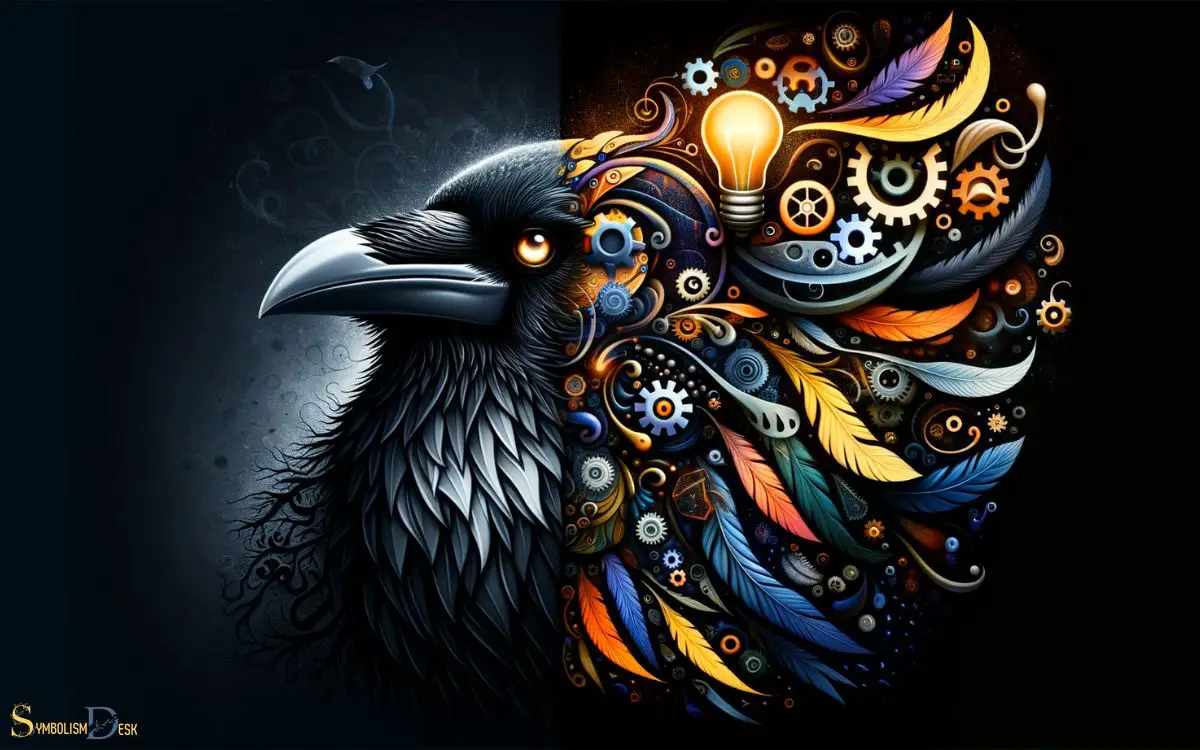
The raven holds significant spiritual meaning in various belief systems around the world. It is often associated with mysticism, magic, and the spirit world.
In many cultures, the raven is considered a messenger between the mortal realm and the afterlife, carrying powerful insights and knowledge.
Here are some examples of the raven’s spiritual significance in different belief systems:
| Belief System | Spiritual Meaning of the Raven |
|---|---|
| Norse Mythology | Associated with Odin, the god of wisdom, and seen as a symbol of insight and guidance. |
| Native American | Regarded as a symbol of transformation, often representing the cycle of death and rebirth. |
| Celtic Tradition | Linked to the supernatural, serving as a guide through the Otherworld and a protector of the lost souls. |
| Hinduism | Portrayed as a vehicle for the god of death, Yama, and a symbol of insight and prophecy. |
These beliefs showcase the diverse and profound spiritual significance attributed to the raven across different cultures.
Conclusion
The raven holds deep symbolic meaning across various cultures and beliefs. From being a messenger of wisdom and intelligence to representing transformation and rebirth, the raven is a powerful symbol in folklore and myths. In Native American mythology, the raven is often seen as a trickster figure, while in Norse mythology, the god Odin was accompanied by two ravens, Huginn and Muninn, who represented thought and memory. The raven’s dark, mysterious nature also ties into the cheshire cat’s enigmatic symbolism, adding to its allure in the collective imagination. Overall, the raven’s symbolism is multifaceted and continues to captivate storytellers and artists alike.
Its presence in spiritual beliefs further emphasizes its significance in the human experience. In the end, the raven’s symbolism speaks volumes, proving that ‘the writing is on the wall’ when it comes to its meaningful presence in our world.






